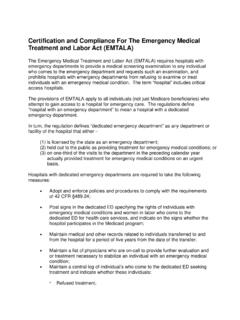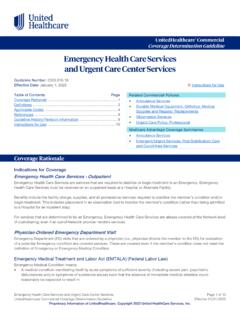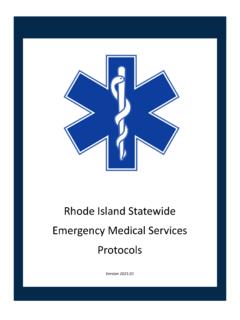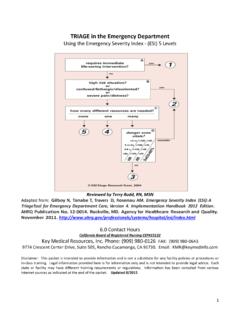Transcription of The Emergency Medical Treatment and Labor Act (EMTALA ...
1 Page 1 of 5 DEPARTMENT OF HEALTH & HUMAN SERVICES Centers for Medicare & Medicaid Services 7500 Security Boulevard, Mail Stop C2-21-16 Baltimore, Maryland 21244-1850 Center for Clinical Standards and Quality Ref: QSO-21-22-Hospitals DATE: September 17, 2021 TO: State Survey Agency Directors FROM: Directors, Quality, Safety & Oversight Group (QSOG) and Survey & Operations Group (SOG) SUBJECT: Reinforcement of EMTALA Obligations specific to Patients who are Pregnant or are Experiencing Pregnancy Loss NOTE: This memorandum is being issued to remind hospitals of their existing obligation to comply with EMTALA and does not contain new policy. Memorandum Summary The Emergency Medical Treatment and Labor Act (EMTALA) provides rights to any individual who comes to a hospital Emergency department and requests examination or Treatment . In particular, if such a request is made, hospitals must provide an appropriate Medical screening examination to determine whether an Emergency Medical condition (EMC) exists or whether the person is in active Labor .
2 If an EMC is found to exist, the hospital must provide either stabilizing Treatment or an appropriate transfer to another hospital that has the capabilities to provide stabilizing Treatment . Hospitals should ensure all staff who may come into contact with a patient seeking Emergency care are aware of the hospital s obligation under EMTALA. A physician s professional and legal duty to provide stabilizing Medical Treatment to a patient who presents to the Emergency department and is found to have an Emergency Medical condition preempts any directly conflicting state law or mandate that might otherwise prohibit or prevent such Treatment . Patients, including pregnant people, are entitled to the full rights and protections afforded under this federal statute. Background The purpose of this memorandum is to restate existing guidance for hospital staff and physicians regarding their obligations under the Emergency Medical Treatment and Labor Act (EMTALA). The EMTALA statute is codified at section 1867 of the Social Security Act, 42 1395dd.
3 Hospitals and physicians generally have three obligations under The first is commonly referred to as the screening requirement, and applies to any individual (including people in Labor ) seeking Emergency care (such as via the hospital s Emergency department or Labor and delivery unit) and for whom a request is made for examination or Treatment for a Medical condition. Such an individual is entitled to have a Medical screening examination to determine whether an Emergency Medical condition (EMC) exists. The second is commonly referred to as the stabilization requirement, which applies to any individual who comes to the hospital whom the hospital determines has an Emergency Medical condition. Such an individual is entitled to stabilizing Treatment within the capability of the hospital. The third obligation flows from the second, and also applies to any individual in a hospital with an Emergency Medical condition. This obligation is sometimes known as the transfer requirement, which restricts the ability of the hospital to transfer that individual to another hospital unless the individual is stabilized.
4 If the individual is not stabilized, they may only be transferred if the individual requests the transfer or if the Medical benefits of the transfer outweigh the risks. While a patient may request a transfer for any reason, a hospital is restricted by EMTALA to transfer patients only after a physician certifies that the Medical benefits of the transfer outweigh the risks. The EMTALA regulation at 42 CFR clarifies that the screening requirement applies to any individual who presents to an area of the hospital that meets the definition of a dedicated Emergency department and makes a request for a Medical screening examination. The regulation defines dedicated Emergency department as the area of the hospital that met any one of three tests: that it is licensed by the state as an Emergency department; that it holds itself out to the public as providing Emergency care; or that during the preceding calendar year, at least one-third of its outpatient visits were for the Treatment of Emergency Medical conditions.
5 Based on this definition, it is possible that the Labor and delivery unit of a hospital could meet the definition of dedicated Emergency department. Medicare Conditions of Participation Although EMTALA does not apply to inpatients, hospitals are still bound by the Medicare conditions of participation (CoPs) to provide appropriate care to inpatients (42 through ). In particular, four CoPs are potentially applicable when a hospital provides Treatment for an admitted patient. For example, the governing body must ensure that the Medical staff as a group is accountable to the governing body for the quality of care provided to patients (42 (a)(5)). Further, the discharge planning CoP (42 ), which requires that hospitals have a discharge planning process, applies to all patients. Hospitals must also have an organized Medical staff that is responsible to the hospital s governing body for the quality of Medical care provided to patients (42 ). Finally, the hospital governing body must ensure that the hospital has an organization-wide quality assessment and performance improvement program to evaluate the provision of patient care (42 R.)
6 These CoPs are intended to protect patient health and safety, and to ensure that high quality Medical care is provided to all patients. Failure to meet these CoPs could result in a finding of noncompliance at the condition level for the hospital and lead to termination of the hospital s Medicare provider agreement. EMTALA There are several specific provisions we wish to call attention to under EMTALA: 1 Appendix V of the CMS State Operations Manual-: Emergency Medical Condition (EMC): Once an individual has presented to the hospital seeking Emergency care, the determination of whether an Emergency Medical Condition exists is made by the examining physician(s) or other qualified Medical personnel of the hospital. Person in Labor Labor is defined to mean the process of childbirth beginning with the latent or early phase of Labor and continuing through the delivery of the placenta. A person experiencing contractions is in true Labor , unless a physician, certified nurse-midwife, or other qualified Medical person acting within their scope of practice as defined in hospital Medical staff bylaws and State law, certifies that, after a reasonable time of observation, the person is in false Labor .
7 Medical Screening Examination Individuals coming to the Emergency department must be provided a Medical screening examination appropriate to the presenting signs and symptoms, as well as the capability and capacity of the hospital. Depending on the individual s presenting signs and symptoms, an appropriate Medical screening exam can involve a wide spectrum of actions, ranging from a simple process involving only a brief history and physical examination to a complex process that also involves performing ancillary studies and procedures, such as (but not limited to) lumbar punctures, clinical laboratory tests, CT scans, and/or other diagnostic tests and procedures. The Medical record must reflect continued monitoring according to the individual s needs until it is determined whether or not the individual has an EMC and, if they do, until they are stabilized or appropriately transferred. There should be evidence of this ongoing monitoring prior to discharge or transfer People in Labor Regardless of State laws, requirements, or other practice guidelines, EMTALA requires that a person in Labor may be transferred only if the individual or their representative requests the transfer or if a physician or other qualified Medical personnel signs a certification, with respect to the person in Labor , that the benefits of the transfer to the woman and/or the unborn child outweigh its risks.
8 2 For example, if the hospital does not have staff or resources to provide obstetrical services, the benefits of a transfer may outweigh the risks. A hospital cannot cite State law or practice as the basis for transfer. Hospitals that are not capable of handling high-risk deliveries or high-risk infants often have written transfer agreements with facilities capable of handling high-risk cases. The hospital must still meet the screening, Treatment , and transfer requirements. Hospital s Obligation A hospital s EMTALA obligation ends when a physician or qualified Medical person has made a decision: That no Emergency Medical condition exists (even though the underlying Medical 2 State Operations Manual: Appendix V Interpretive Guidelines Responsibilities of Medicare Participating Hospitals in Emergency Cases, 52, condition may persist); That an Emergency Medical condition exists and the individual is appropriately transferred to another facility; or That an Emergency Medical condition exists and the individual is admitted to the hospital for further stabilizing Treatment .
9 As indicated above, the determination of an Emergency Medical condition is the responsibility of the examining physician or other qualified Medical personnel. Emergency Medical conditions involving pregnant patients may include, but are not limited to: ectopic pregnancy, complications of pregnancy loss, or emergent hypertensive disorders, such as preeclampsia with severe features. The course of Treatment necessary to resolve such Emergency Medical conditions is also under the purview of the physician or other qualified Medical personnel. Stabilizing Treatment could include Medical and/or surgical interventions ( , dilation and curettage (D&C), removal of one or both fallopian tubes, anti-hypertensive therapy, etc.). The EMTALA statute requires that all patients receive an appropriate Medical screening, stabilizing Treatment , and transfer, if necessary, irrespective of any state laws or mandates that apply to specific procedures. A physician s professional and legal duty to provide stabilizing Medical Treatment to a patient who presents to the Emergency department and is found to have an Emergency Medical condition preempts any directly conflicting state law or mandate that might otherwise prohibit such Treatment .
10 The enforcement of EMTALA is a complaint driven process. The investigation of a hospital s policies/procedures and processes and any subsequent sanctions are initiated by a complaint. If the results of a complaint investigation indicate that a hospital violated one or more of the anti-dumping provisions of 1866 or 1867 (EMTALA), a hospital may be subject to termination of its provider agreement and/or the imposition of civil monetary penalties (CMPs). CMPs may be imposed against hospitals or individual physicians for EMTALA violations. Additionally, physicians may also be subject to exclusion from the Medicare and Medicaid programs. To file an EMTALA complaint, please contact the appropriate state survey agency: Individuals who believe they have been discriminated against on the basis of race, color, national origin, sex (including sexual orientation, gender identity, and pregnancy), age, disability, religion, or the exercise of conscience in programs or activities that HHS directly operates or to which HHS provides federal financial assistance, may file a complaint with the HHS Office for Civil Rights at With regard to civil rights protections against national origin discrimination, hospitals covered by EMTALA must take reasonable steps to provide meaningful access to their programs and activities by persons with limited English proficiency (LEP).



















